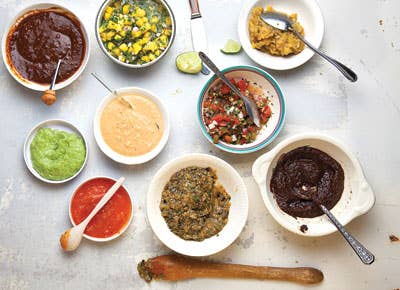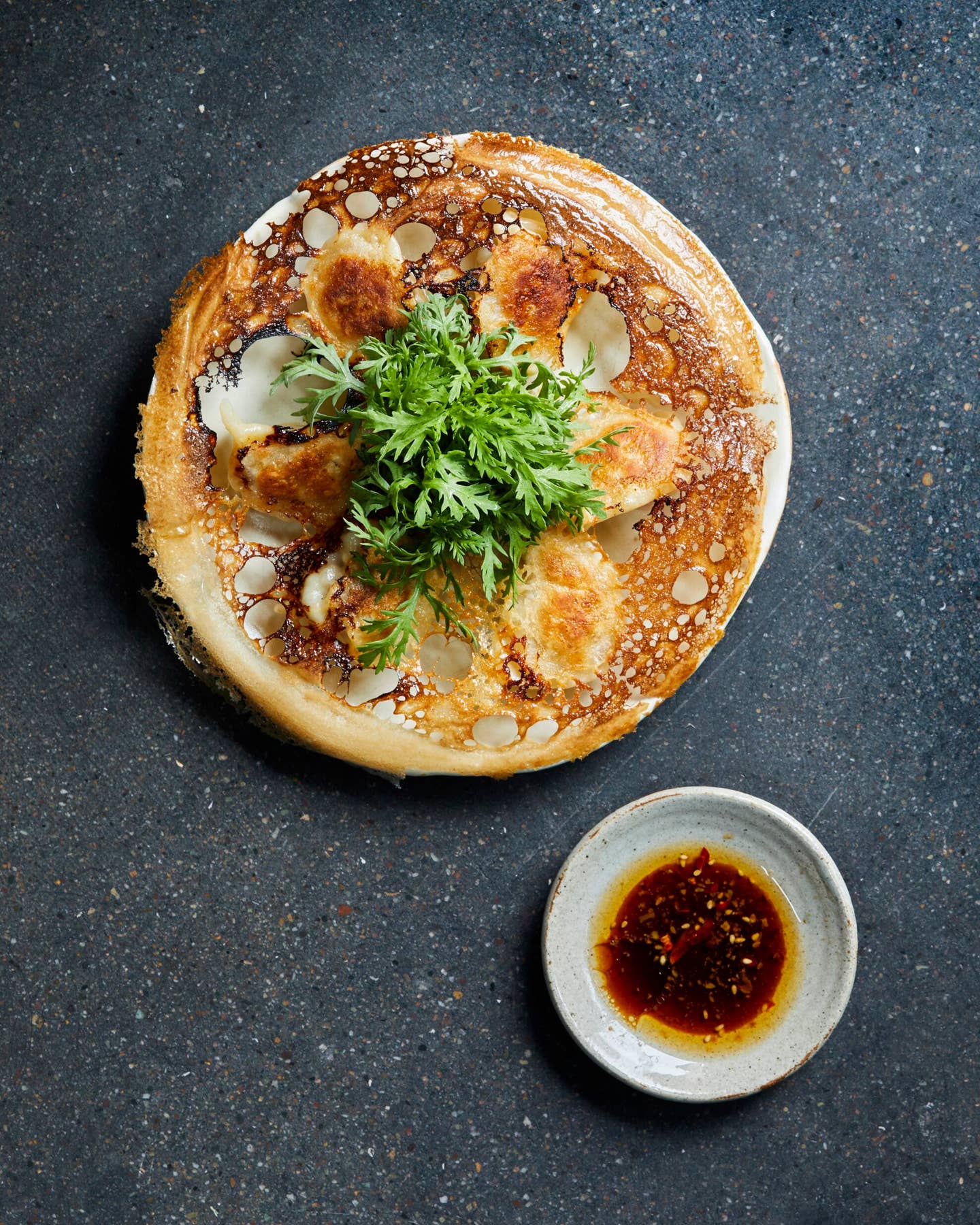
As a high school kid, what drew me to the street food stalls of my native Mexico City was more than just the skill with which my favorite vendors fried, grilled, or stewed. It was the thrill of the salsas served alongside the main event. The best carnitas cook was reliable not only for his tender pork, but also for his bright-green salsa verde cruda, a lush mix of tomatillos, garlic, and fragrant serrano chiles whose heat and bracing acidity cut the meat's richness. I loved the quesadilla maker's brick-red salsa, in which citrusy pulla chiles existed in such perfect balance with garlic that I'd lie awake at night thinking about it.
At home, there was usually salsa roja de molcajete. In theory, its three main ingredients—tomatoes, chiles, and garlic—could produce pasta sauce, but when my aunt Chata made the salsa, the flavor was purely Mexican. She would begin her preparation on a dry, seasoned griddle called a comal, set over a flame. The tomatoes and serrano chiles would blister and blacken, a technique that concentrates the tomatoes' sweetness, transforming them from juicy to silky, and softens the chiles while imparting smoky depth. As she did with many of her salsas, Chata blended it in a molcajete, a mortar and pestle sculpted from volcanic rock. I'd drizzle it on warm tortillas and on Chata's inimitable beans. The bittersweet flavor defined my early life.
Salsa exists to enliven whatever it touches. The word simply means "sauce," and can be many things—a smooth puree, a chunky relish, a potent condiment. They can be raw or cooked, but most of all, salsas are defined by their purpose. One type is soupy, such as chiltomate, a thin, roasted tomato—habanero blend that I like as a braising liquid for pork. Others resemble sauces, to be spooned over an entree—pan-fried peanuts and arbol chiles make a creamy, spicy cloak for shrimp.
Another category, perhaps the most recognizable to Americans, is a raw, chunky condiment, such as pico de gallo: chopped fruits and vegetables seasoned with chiles, herbs, lime juice, and salt. These crisp salsas lend flavor and texture to proteins. Then there are the raw salsas that are broken down into refreshing sauces, such as silky guacamole taquero--tomatillos blended with avocados, serrano chiles, cilantro, and garlic—my choice for dribbling on tacos.
Before the Spanish arrived in the 16th century, Mexicans didn't use the word salsa at all. Indigenous people in Central Mexico called chiles pounded in a mortar with other native ingredients like tomatoes and wild herbs, molli, a Nahuatl word meaning "mixture." Salsas evolved as colonization and trade brought new foods such as limes, garlic, cilantro, and cumin, which came over with the Spanish.
Today, regional salsas are often a reflection of what is grown locally. Avocados are ubiquitous in Mexico, yet you mainly see salsas made with the fruit in the volcanic belt that traverses the country's center, where they are cultivated. In the semiarid north, tomatillos win out over tomatoes; the latter thrive in the subtropical Yucatan, where habanero chiles also grow. This convergence gives us chiltomate, the smoky-sweet salsa.
Despite the influence that geography has on salsa, there are no rules, no one dish that you serve a type of salsa with. And depending on technique, one set of ingredients can produce very different results. Roasting, for instance, renders tomatillos jammy, and mellows seasonings like chiles and garlic. If you prefer chunky salsa, pound garlic, chile, and salt to a paste in a molcajete, then mash in roasted tomatillos. For a smooth salsa, puree those ingredients in the blender. For a concentrated condiment, season the puree to the hilt with salt, lime juice, and chile, to make an intense sauce that matches emphatically flavored foods such as bluefish or lamb. To make a cooking liquid, dilute the sauce with water and simmer it to meld the flavors.
After making a few typical Mexican salsas, you might find yourself ditching recipes—substituting scallions for onions, or roasting peaches instead of tomatoes. That's what I do when I come home at night, too exhausted to cook. I look in my fridge and see what I have—maybe a few tomatoes and chiles—and broil them until they blister. I mash the chiles with garlic and salt, then mix in the roasted tomatoes. I breathe in the aroma. Now I'm home.
Roberto Santibañez is the chef-owner of Fonda restaurant in Brooklyn, New York, and author of_Truly Mexican: Essential Recipes and Techniques for Authentic Mexican Cooking (Wiley, 2011)._
Keep Reading
Continue to Next Story










